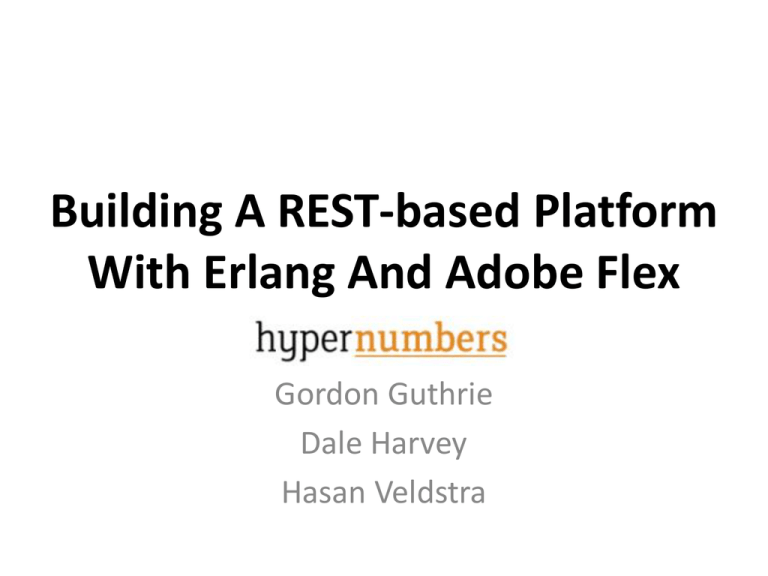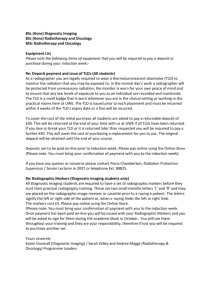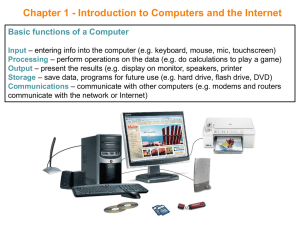Project Playfair Investor Day Planning
advertisement

Building A REST-based Platform
With Erlang And Adobe Flex
Gordon Guthrie
Dale Harvey
Hasan Veldstra
This presentation the details of the
platform, in particular how Erlang and
Flex are a match made in heaven
• The Product
– the hypernumbers Matrix Server
• API Design
• Adobe Flex
• Next Steps
what we have been working on
THE PRODUCT
The product is a server codenamed ‘William Playfair’
that serves hypernumbers - named
after the Scotsman who invented the graph in 1759
At first glance our product looks like ‘a
spreadsheet on the web’ but our goal is
actually to make ‘a spreadsheet of the web’
Each page has a URL – to create a
new page just type in a new path and
populate a cell
Each cell has a URL
This means that all cells exist in a single
namespace – there is therefore only ‘1 spreadsheet’
So the cells on my websheet can update
the cells on yours directly (or your graphs
or other applications and components)
The critical thing is that it is a platform for
the delivery of hypernumbers and
products/GUI’s that use them...
Browser On The Desktop
http://acme.corp/page1
1
2
3
4
5
B
Sales
X Ltd
£128,000
Y PLC
£16,000
Z GmbH
£33,750
Total Other
£72,2550
GUI’s
Other Services
A
Web Server
Database
The critical decision is to treat ‘pages’ and
‘cells’ (or parts of pages) separately, and
only use Flash for single pages...
• a page is terminated by a slash:
proto://subbies.domain.tld[:port]/page/path/
• a cell is not:
proto://subbies.domain.tld[:port]/page/path/ab23
• and we use query’s to build the API:
proto://subbies.domain.tld[:port]/page/path/ab23?toolbar
This gives us a simple loading cycle – the page
URL loads the GUI as a single object and the
Flash init() event builds the GUI
GUI files are associated with nodes in the path tree
via the management console – drop your own in for
the whole of the part of the Information Architecture
So how do we actually use a hypernumber
– what do the building blocks of this
platform actually consist of?
You set the value of a hypernumber with an http(s) POST:
protocol://subbies.domain.tld[:port]/page/path/ab23
with
action=create
value=12345
value can be:
a number
a string
a formula
12345
“bob”
=1+2
=a1+b2
cells on the same page
=/some/other/page/a1
absolute page addressing
=/a/page/name(“sub-total”)
by cell name
=../../relative/page/b1
relative page addressing
=hypernumber(“proto://sub.dom.tld:port/mypage/a3”)
and you get the value using an http(s) GET:
protocol://subbies.domain.tld[:port]/page/path/ab23
You can use a whole range of formulas
(also available in Microsoft Excel!) or
write your own server-side one
abs/1,
acos/1,
acosh/1,
address/5,
andf/1,
asc/1,
areas/1,
asin/1,
asinh/1,
atan/1,
atan2/2,
atanh/1,
avedev/1,
average/1,
averagea/1,
betadist/5,
betainv/5,
binomdist/4,
calculate/2,
ceiling/2,
cell/2,
char/1,
chidist/2,
chiinv/2,
chitest/2,
choose/1,
clean/1,
code/1,
column/1,
columns/1,
combin/2,
concatenate/1,
confidence/3,
correl/2,
cos/1,
cosh/1,
count/1,
counta/1,
countblank/1,
countif/2,
covar/2,
critbinom/3,
date/3,
datevalue/1,
day/1,
days360/3,
daverage/4,
db/4,
db/5,
dcount/4,
dcounta/4,
ddb/4,
ddb/5,
devsq/1,
dget/4,
dydx/2,
days360/2,
error_type/1,
even/1,
exact/2,
exp/1,
expondist/3,
fact/1,
false/0,
fdist/3,
find/2,
find/3,
findb/2,
findb/3,
finv/3,
fisher/1,
fisherinv/1,
fixed/1,
fixed/2,
fixed/3,
floor/2,
forecast/3,
frequency/2,
ftest/2,
fv/3,
fv/4,
fv/5,
gammadist/4,
gammainv/3,
gammaln/1,
geomean/1,
gestep/1,
gestep/2,
growth/4,
harmean/1,
hour/1,
hypgeomdist/4,
iff/3,
index/4,
indirect/1,
int/1,
integrate/2,
intercept/2,
ipmt/4,
ipmt/5,
ipmt/6,
irr/1,
irr/2,
iserr/1,
iserror/1,
is_list_number/1,
islogical/1,
isna/1,
isnontext/1,
isnumber/1,
ispmt/4,
istext/1,
jis/1,
kurt/1,
large/2,
left/1,
left/2,
leftb/1,
leftb/2,
len/1,
lenb/1,
linest/2,
linest/3,
ln/1,
log/1,
log/2,
log10/1,
lower/1,
max/1,
maxa/1,
mdeterm/1,
median/1,
mid/3,
midb/3,
min/1,
mina/1,
minute/1,
minverse/2,
mmult/4,
mod/2,
mode/1,
month/1,
n/1,
na/0,
notf/1,
normdist/4,
normsdist/1,
now/0,
odd/1,
orf/1,
permut/2,
pi/0,
pound/1,
pound/2,
power/2,
product/1,
radians/1,
rand/0,
replace/4,
rept/2,
right/1,
right/2,
rightb/1,
rightb/2,
round/2,
rounddown/2,
roundup/2,
search/2,
search/3,
searchb/2,
searchb/3,
second/1,
sign/1,
sin/1,
sinh/1,
small/2,
sqrt/1,
standardise/3,
stdev/1,
stdevp/1,
substitute/3,
substitute/4,
sum/1,
sumproduct/2,
sumsq/1,
tan/1,
tanh/1,
today/0,
trim/1,
true/0,
type/1,
upper/1,
value/1,
var/1,
varp/1,
year/1,
cumulate/1,
percentile/2,
proper/1,
quartile/2,
rank/2,
rank/3,
rows/2,
pearson/2,
moment/2,
skew/1,
slope/2,
steyx/2,
stdeva/1,
subtotal/2,
sumif/2,
sumif/3,
sumx2my2/2,
sumx2py2/2,
sumxmy2/2,
trend/3,
trend/4,
transpose/2,
trimmean/2,
trunc/1,
trunc/2,
vara/1,
varpa/1,
weibull/4
You can address multiple cells in a variety of
different ways using URL’s as well and these URL’s
will return lists that can be directly used in formulae
proto://sub.dom.tld/page/path/ab12:cd34
proto://sub.dom.tld/page/path/ab
proto://sub.dom.tld/page/path/12
proto://sub.dom.tld/page/path/ab23:cd34,x1:y3
proto://sub.dom.tld/page/path/ab23:cd34,x1:y3
a range
a whole column
a whole row
a union
an intersection
There are three substantial API’s in the product
– all with different characteristics - which are
required for different purposes
Web Browser
Web Browser
Web Browser
Key
Vertical API V1.0
Vertical API V2.0
Vertical API V3.0
Horizontal API
Remoting API
WebSheet Server
Version 2
WebSheet Server
Version 1
WebSheet Server
Version 3
The horizontal API is how one cell
establishes a relationship with another
cell on a different server
Request to set up a hypernumber link:
protocol://subbies.domain.tld/path/to/a/page/ab23
with
action=register
registered_URL=the URL of the cell to be updated
proxy_URL=the URL that the notification is posted to
biccie=a ‘biccie’
Notify a registered cell that the value has changed:
protocol://proxy.domain.tld/path/to/a/page/ab23
with
action=notify
type=change
notifying_URL=the URL of the cell(s) that are notifying
registered_URL=the URL of the cell to be updated
value=fully qualified hypernumber
biccie=a ‘biccie’
version=page_version
...and the horizontal API also includes a
small number of structural elements that
are required to make the system work...
• Notification of structural changes
“I have deleted this column on this page”
“I have inserted a 3x5 block at this cell”
“I have deleted the name ‘sales’”
• These require remote sites to rewrite their
formulae or mark their values as #undefined
...the horizontal API is entirely POST
based and has three core ‘verbs’ that
provide it with structure...
register
unregister
notify
set up hypernumber links
tear down hypernumber links
notify remote sites of value/structural changes
The vertical API delivers functionality to a
particular user or set of users and is a
mixture of POST and GET based
Read
• Returns something
• GET
Create/Update
• Creates or updates a value in a cell or cells or a named range
• POST
action=create
Clear
• Clears the values in a cell or cells, a named set of cells or a page
• POST
action=clear
Insert
• Inserts new cells causing reorganisation of the grid
• POST
action=insert
Delete
• Deletes cells causing reorganisation of the grid – or deletes a named set of cells
(leaving the cells themselves unchanged)
• POST
action=delete
The meat of the read component is
provided by decorating the URL’s with
appropriate queries
• Get a cell formatted as a hypernumber
protocol://subbies.domain.tld[:port]/path/to/a/page/a?hypernumber
• Get the information required to populate the toolbar for a cell
with focus:
protocol://subbies.domain.tld[:port]/path/to/a/page/ab23?toolbar
• Get details of the cells a particular cell is link_to or linked_from
returning the result in a particular format:
protocol://sub.domain.tld/page/path/ab23?[link_to|link_from],format=[xml|json]
...the hypernumber format is simply a list showing
the current value of the cell, the reference tree (used
to check for circular references) and any errors that
have bubbled up
...the toolbar wants to know where the current
cell takes values from and where its value is
used, so that you can browse from one page to
another – as well as other details
...the remoting API is socket based – a GUI (or a
chart) registers that it is looking at a section of
the matrix and it can then be notified in realtime of changes to the underlying data
The client uses three verbs:
authenticate cookie
uses the http cookie
register proto://sub.dom.tld/some/page/a1:j9
unregister proto://sub.dom.tld/some/page/a1:j9
The server responds with one verb:
change proto://sub.dom.tld/some/page/a1 99
...and there are a number of possible
extensions – we welcome your views and
ideas on these – they include:
Summary/query URLs:
•
•
proto://sub.dom.tld/expenses/gordon/2007/Aug
proto://sub.dom.tld/expenses/*/2007/*/sum(name(total))
Negative, complex and floating cell addresses:
•
proto://sub.dom.tld/page/path/aa.bc+ix-33.3+i5
...and there are a number of different
components of the product that are of interest
– in particular the Mnesia management panel...
...but also the delivery platform which is a
customised version of Ubuntu with a
single-click installer...
• based on Dapper Drake 6.06 (LTS)
• customised with the Ubuntu Customisation Kit
(uck)
• basic platform will include an Erlang
distribution system (eg CEAN)
– Ideally with split repositories so that our
application can be updated from within the
general Erlang distribution
• to be open-sourced
what we have been working on
ADOBE FLEX
Flex is a mark-up language that compiles to
Action Script 3.0 – which is an ECMA-262
compliant scripting language – it is a close
cousin of Javascript and quite recognisable
Styles:
DataGrid {
backgroundColor: #ffffff;
horizontalGridLines: true;
letterSpacing: 0;
horizontalGridLineColor: #666666;
useRollOver: false;
rollOverColor: #666666;
fontFamily: Tahoma;
fontSize: 11; }
Functions:
private function loadLinksFrom(event:ResultEvent):void
{
link_to.dataProvider = new Array();
for each (var linksto:XML in event.result.link)
link_to.dataProvider.addItem({label:linksto.site.toString()+
linksto.path.toString()});
}
...but it is the collections of prebuilt
components that can be configured through a
mark up language that make it so powerful
<menuitem label="Formulas">
<menuitem label="Maths" data="Maths">
<menuitem label="Arithmetic">
<menuitem label="sum" data="sum()"/>
<menuitem label="product" data="product()"/>
<menuitem label="abs" data="abs()"/>
<menuitem label="sqrt" data="sqrt()"/>
<menuitem label="power" data="power(,)"/>
<menuitem label="sign" data="sign()"/>
<menuitem label="exp" data="exp()"/>
<menuitem label="fact" data="fact()"/>
<menuitem label="mod" data="mod(,)"/>
</menuitem>
</menuitem>
</menuitem>
...just drop binary files onto the server
docroot and configure the matrix server
through a GUI and you are ‘good to go’
• loose binary integration
– very clean
– allows a secondary market to develop
• powerful platform that is available on around
90% of desktops
• genuinely cross-platform
• socket and http-based connectivity
• well suited to a ‘naïve’ coding style (eg loads
of concurrent connections to yaws)
What happens now
NEXT STEPS
...we are currently seedfunded through a panEuropean VC-backed funding contest called
Seedcamp but need to step up a notch...
Backers include:
•Eden
•Amadeus
•Venrex
•Atomico
•Northzone
Backers include
•Highland Capital Partners
•Index
•DJFEsprit
•Atlas Venture
•Benchmark Capital
...looking to raise Series ‘A’ and make
some significant technical and nontechnical hires in the near future...
• launch before Xmas
• go into Series ‘A’ funding
• make significant hires
• including senior Erlang positions



